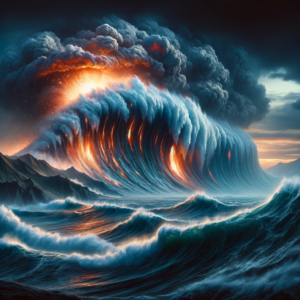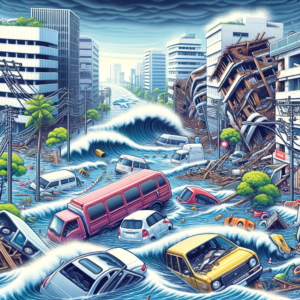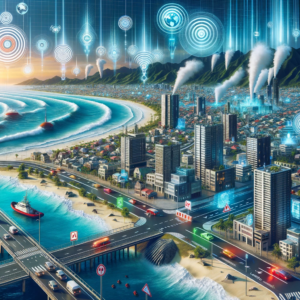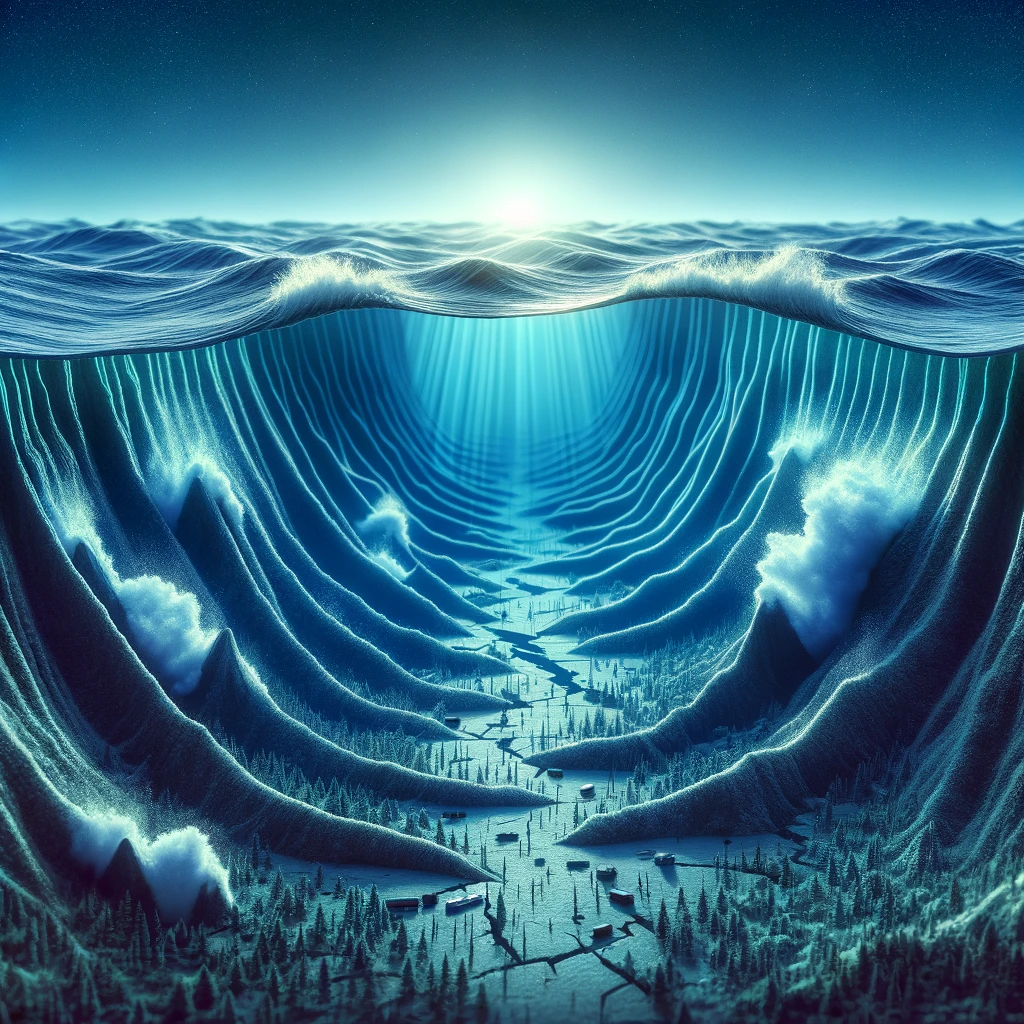津波のメカニズム
目次
- 津波の成因
- 地震による津波
- 火山活動による津波
- 地すべりによる津波
- 津波の伝播
- 深海での挙動
- 沿岸への接近
- 津波の影響
- 物理的破壊
- 人的被害
- 経済的影響
- 予測と対策
- 予測技術
- 防災教育
- 物理的対策
1. 津波の成因

地震による津波
- 地震が海底で発生すると、海底の断層が動き、水柱が押し上げられ、津波が発生します。
- 特にプレート境界で発生する「海溝型地震」は、大規模な津波を引き起こす可能性が高いです。
- 歴史的な例として、2004年のインド洋大地震や2011年の東日本大震災が挙げられます。
火山活動による津波
- 火山の大規模な爆発や山体崩壊は、海に大量の物質が投入され、津波を発生させます。
- 火山島の崩壊やカルデラの形成が原因で発生することが多いです。
- 1883年のクラカタウ噴火が引き起こした津波は、広範囲に甚大な被害をもたらしました。
地すべりによる津波
- 陸地や海底での大規模な土砂崩れが原因で発生します。
- これらの津波は局地的ですが、非常に高い波を生じることがあります。
- 1958年のアラスカ・リトヤ湾の事例は、史上最も高い津波を記録しました。
2. 津波の伝播

深海での挙動
- 津波は深海では波高が低く、時速500km以上に達することもあります。
- 海洋を横断して遠隔地に到達する能力があります。
沿岸への接近
- 沿岸に近づくにつれて、津波は速度を落とし、波高を増します。
- 沿岸部では、津波は高さが数メートルから数十メートルに達し、大規模な破壊を引き起こします。
3. 津波の影響

物理的破壊
- 建物、橋、道路などのインフラが津波により破壊されます。
- 強い水流は車両や船舶を巻き込み、被害を拡大します。
人的被害
- 避難時間が限られているため、津波は大きな人的被害をもたらすことがあります。
- 死傷者は溺死、物体による打撃、建物の倒壊など多様な原因で発生します。
経済的影響
- 津波によるインフラの破壊は、復旧に膨大なコストを要します。
- 漁業、観光業、商業などが特に影響を受けることが多いです。
4. 予測と対策

予測技術
- 地震計や津波計による早期発見が重要です。衛星データやコンピュータモデリングも活用されます。
- これらの技術により、発生から数分以内に警報を発することが可能です。
防災教育
- 津波の危険性を理解し、適切に避難する方法を学ぶための教育が重要です。
- 定期的な訓練やワークショップが実施されています。
物理的対策
- 防波堤の建設や高台への避難路の整備が行われています。
- 避難ビルの建設なども、安全確保のために進められています。
このように、津波は予測が難しい自然災害ですが、適切な予測技術、教育、物理的対策により、その被害を最小限に抑えることが可能です。科学技術の進歩と共に、より効果的な津波対策を進めていくことが重要です。
Tsunami Mechanism
Table of Contents
- Causes of Tsunamis
- Tsunamis Caused by Earthquakes
- Tsunamis Caused by Volcanic Activity
- Tsunamis Caused by Landslides
- Tsunami Propagation
- Behavior in the Deep Sea
- Approaching the Coast
- Impacts of Tsunamis
- Physical Destruction
- Human Casualties
- Economic Impacts
- Prediction and Countermeasures
- Prediction Technologies
- Disaster Prevention Education
- Physical Measures
- Causes of Tsunamis
Tsunamis Caused by Earthquakes Tsunamis are generated when an earthquake occurs underwater, moving the seabed fault and pushing up a column of water. Particularly, “trench-type earthquakes” at plate boundaries have a high potential for causing large-scale tsunamis. Historical examples include the 2004 Indian Ocean earthquake and the 2011 Great East Japan Earthquake.
Tsunamis Caused by Volcanic Activity Large-scale volcanic eruptions or collapses can cause tsunamis by dumping massive amounts of material into the sea. They are often caused by the collapse of volcanic islands or the formation of calderas. The tsunami caused by the 1883 eruption of Krakatoa resulted in widespread devastation.
Tsunamis Caused by Landslides Tsunamis can also be triggered by large-scale landslides on land or at sea. These tsunamis are localized but can generate extremely high waves. The 1958 Lituya Bay megatsunami in Alaska recorded the highest ever tsunami wave.
- Tsunami Propagation
Behavior in the Deep Sea In the deep sea, tsunamis have low wave heights but can travel over 500 km/h. They have the capability to cross oceans and reach distant lands.
Approaching the Coast As they approach the coast, tsunamis slow down and increase in wave height, causing extensive damage in coastal areas.
- Impacts of Tsunamis
Physical Destruction Tsunamis destroy buildings, bridges, roads, and other infrastructure. Strong currents can sweep away vehicles and ships, increasing the damage.
Human Casualties Limited evacuation time can lead to significant human casualties. Deaths and injuries occur due to drowning, impact from debris, and collapsing structures.
Economic Impacts The destruction of infrastructure by tsunamis requires substantial costs for recovery. Industries like fishing, tourism, and commerce are often heavily affected.
- Prediction and Countermeasures
Prediction Technologies Early detection using seismographs and tsunami gauges is crucial. Satellite data and computer modeling are also utilized. These technologies enable warnings to be issued within minutes of occurrence.
Disaster Prevention Education Understanding the risks of tsunamis and learning appropriate evacuation methods is essential. Regular drills and workshops are conducted.
Physical Measures Construction of sea walls and establishment of evacuation routes to higher ground are implemented. Building evacuation structures is also a part of ensuring safety.
Thus, while tsunamis are difficult to predict natural disasters, minimizing their damage is possible through appropriate prediction technologies, education, and physical measures. Advancing science and technology is crucial for developing more effective tsunami countermeasures.



コメント